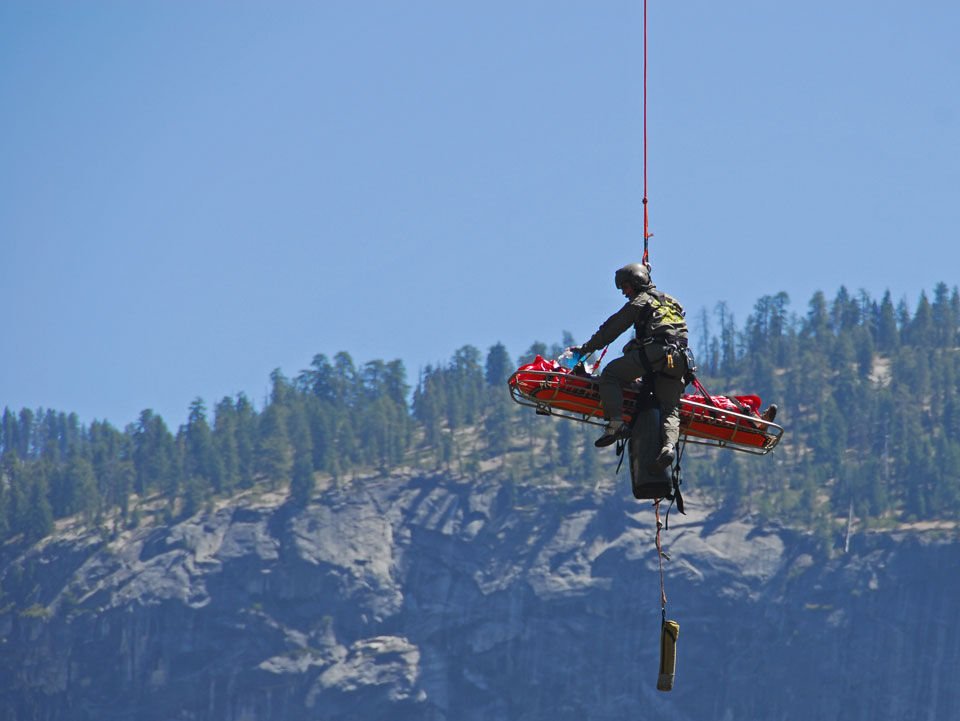On the afternoon of June 24, 2017, a hiker slipped on granite while crossing Tenaya Creek upstream of Hidden Falls; she fell 30 feet over the waterfall onto the rocks below. One of the subject’s friends waited with her, while the other hiked back to the Mirror Lake Trail to call 911 for help. The friend waited for rescuers to arrive on the trail so that she could guide rescuers to the off-trail location of the injured subject.
Once rescuers arrived on scene, they worked quickly to stabilize the subject and prepare her for a short-haul rescue. A short-haul rescue is a method in which one or more persons (subjects and/or rescuers) are suspended on a fixed line (100–250 feet) beneath a helicopter. The suspended persons are then transported a short distance (short-haul) through the air, normally from an inaccessible location to a safe landing area. Due to the extent of her injuries, the subject was not moved out of the water before rescuers could carefully place her in the litter. Rescuers became concerned about the subject becoming hypothermic, since the water flowing over Hidden Falls originates as snowmelt. “It was pretty scary waiting for a long time and not knowing if they were going to find me,” reflected the subject. But once rescuers arrived on scene the subject felt relieved and appreciated the open communication that rescuers had with her regarding incident operations.

Although patient care was paramount on rescuers’ minds, the extraction method was carefully considered since it greatly impacted rescuer safety. One rescuer noted, “Using the helicopter was probably the best way to [extract the subject due to] the nature of her injuries and in terms of keeping rescuers safe.” A litter carryout from this location presented several hazards to rescuers including off-trail travel, boulder fields, and large downed trees. “It would have put a lot of people in danger to extract her from there [via a litter carry out] because the trail conditions were nonexistent,” stated a rescuer.
The subject was short-hauled to Ahwahnee Meadow despite a burst of heavy rain at Hidden Falls. Once 551, the park’s contract helicopter, landed in Ahwahnee Meadow, the subject was transferred to the care of Yosemite National Park EMS staff and, later, to a medical helicopter that flew her to a hospital. At the hospital, the subject learned that she had fractured her pelvis, L-3 vertebra, and right hip. “It’s definitely extremely humbling,” stated the subject regarding the injuries she sustained. She further explained that her physicians told her “[L-3 is the lowest [vertebrae] you can break without having permanent spinal cord damage, [or paralysis].”
The subject made a full recovery and continues to recreate in Yosemite. “[The incident] made me realize that despite an injury you can’t just give up what you love to do.”
Lessons Learned
Be aware of changing stream conditions due to varied water levels. In the spring, water rages down the Merced River and other waterways into Yosemite Valley. As the water level lowers throughout the summer, rocks that were once under water become exposed. Be cautious when scrambling in stream beds because rocks that are currently exposed may have been underwater earlier in the year, causing them to be water polished.
Be aware of downstream hazards. When crossing a stream, be aware of downstream hazards and the consequences of losing your footing at that location. A rescuer noted, “ If [the subject] had been crossing somewhere else and she messed up, it could have been even more catastrophic depending on what was below her, or it could have been less.” Often visitors wade or swim above Yosemite’s waterfalls, not completely recognizing the hazard downstream of them.
Respect natural elements. The glacially polished granite in Yosemite is slippery even when dry. When wet, the smooth granite practically becomes a frictionless surface. Recognizing the inherent danger of scrambling on granite boulders and surfaces encourages visitors to make more informed choices about their recreational activities. “You are submitting to the elements when you are doing outdoor activities,” reflected the subject as she described the lesson taken away from the incident. “I think I have a lot more respect for Mother Nature, for the unforgiving planet, and it made me realize that even the best climbers and hikers in the world are not immune to Mother Nature and the elements.” The subject also noted that her situational awareness and risk management process has benefically changed due to the incident. “Before I would take a lot more risks, jumping across things or climbing something that is not necessarily super safe. It was honestly a really beneficial wake-up call that even though I am 22 years old, I am not indestructible and I need to be aware of my surroundings to be a good outdoor person.”
